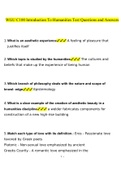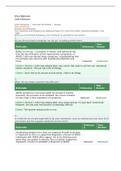Test Bank for Introduction to Maternity and Pediatric
Nursing 9th Edition BY Gloria Leifer Chapter 1-34
Newest Version 2024
,Chapter 01: The Past, Present, and Future
Leifer: Introduction to Maternity and Pediatric Nursing, 9th Edition
MULTIPLE CHOICE
1. A patient chooses to have the certified nurse-midwife (CNM) provide care during her
pregnancy. What does the CNM‘s scope of practice include?
a. Practice independent from medical supervision
b. Comprehensive prenatal care
c. Attendance at all deliveries
d. Cesarean sections
ANS: B
The CNM provides comprehensive prenatal and postnatal care, attends uncomplicated
deliveries, and ensures that a backup physician is available in case of unforeseen problems.
DIF: Cognitive Level: Comprehension REF: p. 6 OBJ: 5
TOP: Advance Practice Nursing Roles KEY: Nursing Process Step: Implementation
MSC: NCLEX: Health Promotion and Maintenance: Prevention and Early Detection of Disease
2. Which medical pioneer discovered the relationship between the incidence of puerperal fever
and unwashed hands?
a. Karl Credé
b. Ignaz Semmelweis
c. Louis Pasteur
d. Joseph Lister
ANS: B
Ignaz Semmelweis deduced that puerperal fever was septic, contagious, and transmitted by
the unwashed hands of physicians and medical students.
DIF: Cognitive Level: Knowledge REF: p. 2 OBJ: 1
TOP: The Past KEY: Nursing Process Step: N/A
MSC: NCLEX: Safe, Effective Care Environment: Safety and Infection Control
3. A pregnant woman who has recently immigrated to the United States comments to the nurse,
“I am afraid of childbirth. It is so dangerous. I am afraid I will die.” What is the best nursing
response reflecting cultural sensitivity?
a. “Maternal mortality in the United States is extremely low.”
b. “Anesthesia is available to relieve pain during labor and childbirth.”
c. “Tell me why you are afraid of childbirth.”
d. “Your condition will be monitored during labor and delivery.”
ANS: C
Asking the patient about her concerns helps promote understanding and individualizes patient
care.
DIF: Cognitive Level: Application REF: pp. 6-8 OBJ: 8
TOP: Cross-Cultural Care KEY: Nursing Process Step: Implementation
MSC: NCLEX: Psychosocial Integrity: Psychological Adaptation
,4. An urban area has been reported to have a high perinatal mortality rate. What information
does this provide?
a. Maternal and infant deaths per 100,000 live births per year
b. Deaths of fetuses weighing more than 500 g per 10,000 births per year
c. Deaths of infants up to 1 year of age per 1000 live births per year
d. Fetal and neonatal deaths per 1000 live births per year
ANS: D
The perinatal mortality rate includes fetal and neonatal deaths per 1000 live births per year.
DIF: Cognitive Level: Comprehension REF: p. 13 | Box 1.6
OBJ: 9 TOP: The Present-Child Care
KEY: Nursing Process Step: Implementation
MSC: NCLEX: Safe, Effective Care Environment: Coordinated Care
5. What is the focus of current maternity practice?
a. Hospital births for the majority of women
b. The traditional family unit
c. Separation of labor rooms from delivery rooms
d. A quality family experience for each patient
ANS: D
Current maternity practice focuses on a high-quality family experience for all families,
traditional or otherwise.
DIF: Cognitive Level: Comprehension REF: p. 6 OBJ: 5
TOP: The Present-Maternity Care KEY: Nursing Process Step: N/A
MSC: NCLEX: Health Promotion and Maintenance
6. Who advocated the establishment of the Children‘s Bureau?
a. Lillian Wald
b. Florence Nightingale
c. Florence Kelly
d. Clara Barton
ANS: A
Lillian Wald is credited with suggesting the establishment of a federal Children‘s Bureau.
DIF: Cognitive Level: Knowledge REF: p. 4 OBJ: 1 | 2
TOP: The Past KEY: Nursing Process Step: Implementation
MSC: NCLEX: Health Promotion and Maintenance: Growth and Development
7. What was the result of research done in the 1930s by the Children‘s Bureau?
a. Children with heart problems are now cared for by pediatric cardiologists.
b. The Child Abuse and Prevention Act was passed.
c. Hot lunch programs were established in many schools.
d. Children‘s asylums were founded.
ANS: C
School hot lunch programs were developed as a result of research by the Children‘s Bureau on
the effects of economic depression on children.
DIF: Cognitive Level: Knowledge REF: p. 4 OBJ: 2 | 3
, TOP: The Past KEY: Nursing Process Step: N/A
MSC: NCLEX: Health Promotion and Maintenance: Coordinated Care
8. What government program was implemented to increase the educational exposure of
preschool children?
a. WIC
b. Title XIX of Medicaid
c. The Children‘s Charter
d. Head Start
ANS: D
Head Start programs were established to increase educational exposure of preschool children.
DIF: Cognitive Level: Knowledge REF: p. 3 OBJ: 3
TOP: Government Influences in Maternity and Pediatric Care KEY: Nursing Process Step: N/A
MSC: NCLEX: Health Promotion and Maintenance: Growth and Development
9. What guidelines define multidisciplinary patient care in terms of expected outcome and
timeframe from different areas of care provision?
a. Clinical pathways
b. Nursing outcome criteria
c. Standards of care
d. Nursing care plan
ANS: A
Clinical pathways, also known as critical pathways or care maps, are collaborative guidelines
that define patient care across disciplines. Expected progress within a specified timeline is
identified.
DIF: Cognitive Level: Knowledge REF: p. 13 OBJ: 10
TOP: Health Care Delivery Systems KEY: Nursing Process Step: N/A
MSC: NCLEX: Safe, Effective Care Environment: Coordinated Care
10. A nursing student has reviewed a hospitalized pediatric patient chart, interviewed her mother,
and collected admission data. What is the next step the student will take to develop a nursing
care plan for this child?
a. Identify measurable outcomes with a timeline.
b. Choose specific nursing interventions for the child.
c. Determine appropriate nursing diagnoses.
d. State nursing actions related to the child‘s medical diagnosis.
ANS: C
The nurse uses assessment data to select appropriate nursing diagnoses. Outcomes and
interventions are then developed to address the relevant nursing diagnoses.
DIF: Cognitive Level: Application REF: p. 12 OBJ: 7
TOP: Nursing Process KEY: Nursing Process Step: Nursing Diagnosis
MSC: NCLEX: Safe, Effective Care Environment: Coordinated Care
11. A nursing student on an obstetric rotation questions the floor nurse about the definition of the
LVN/LPN scope of practice. What resource can the nurse suggest to the student?
a. American Nurses Association
, b. State’s Board of Nursing
c. Joint Commission
d. Association of Women‘s Health, Obstetric and Neonatal Nurses
ANS: B
The scope of practice of the LVN/LPN is published by the state‘s board of nursing.
DIF: Cognitive Level: Comprehension REF: p. 16 OBJ: 2
TOP: Critical Thinking KEY: Nursing Process Step: Implementation
MSC: NCLEX: Safe, Effective Care Environment: Coordinated Care
12. What was recommended by Karl Credé in 1884?
a. All women should be delivered in a hospital setting.
b. Chemical means should be used to combat infection.
c. Podalic version should be done on all fetuses.
d. Silver nitrate should be placed in the eyes of newborns.
ANS: D
In 1884 Karl Credé recommended the use of 2% silver nitrate in the eyes of newborns to
reduce the incidence of blindness.
DIF: Cognitive Level: Knowledge REF: p. 2 OBJ: 1
TOP: Use of Silver Nitrate KEY: Nursing Process Step: N/A
MSC: NCLEX: Health Promotion and Maintenance: Prevention and Early Detection of Disease
13. What is the purpose of the White House Conference on Children and Youth?
a. Set criteria for normal growth patterns.
b. Examine the number of live births in minority populations.
c. Raise money to support well-child clinics in rural areas.
d. Promote comprehensive child welfare.
ANS: D
White House Conferences on Children and Youth are held every 10 years to promote
comprehensive child welfare.
DIF: Cognitive Level: Knowledge REF: p. 4 OBJ: 2
TOP: White House Conferences KEY: Nursing Process Step: N/A
MSC: NCLEX: Health Promotion and Maintenance: Prevention and Early Detection of Disease
14. How many hours of hospital stay does legislation currently allow for a postpartum patient
who has delivered vaginally without complications?
a. 24
b. 48
c. 36
d. 72
ANS: B
Postpartum patients who deliver vaginally stay in the hospital for an average of 48 hours;
patients who have had a cesarean delivery usually stay 4 days.
DIF: Cognitive Level: Knowledge REF: p. 6 OBJ: 5
TOP: Hospital Terms for Postpartum Patients
KEY: Nursing Process Step: Planning
, MSC: NCLEX: Health Promotion and Maintenance: Prevention and Early Detection of Disease
15. How does the clinical pathway or critical pathway improve quality of care?
a. Lists diagnosis-specific implementations
b. Outlines expected progress with stated timelines
c. Prioritizes effective nursing diagnoses
d. Describes common complications
ANS: B
Critical pathways outline expected progress with stated timelines. Any deviation from those
timelines is called a variance.
DIF: Cognitive Level: Comprehension REF: p. 13 OBJ: 10
TOP: Critical Pathway KEY: Nursing Process Step: Implementation
MSC: NCLEX: Safe, Effective Care Environment: Coordinated Care
16. A patient asks the nurse to explain what is meant by “gene therapy.” What is the nurse‘s best
response?
a. Gene therapy can replace missing genes.
b. Gene therapy evaluates the parent‘s genes.
c. Gene therapy can change the sex of the fetus.
d. Gene therapy supports the regeneration of defective genes.
ANS: A
Gene therapy can replace missing or defective genes.
DIF: Cognitive Level: Knowledge REF: p. 8 OBJ: 5
TOP: Gene Therapy KEY: Nursing Process Step: Implementation
MSC: NCLEX: Health Promotion and Maintenance: Prevention and Early Detection of Disease
17. The nurse is clarifying information to a patient regarding diagnosis-related groups (DRGs).
What is the nurse‘s best response when the patient asks how DRGs reduce medical care costs?
a.By determining payment based on diagnosis
b.By requiring two medical opinions to confirm a diagnosis
c.By organizing HMOs
d.By defining a person who will require hospitalization
ANS: A
DRGs determine the amount of payment and length of hospital stay based on the diagnosis.
DIF: Cognitive Level: Comprehension REF: p. 8 OBJ: 3
TOP: DRGs KEY: Nursing Process Step: Implementation
MSC: NCLEX: Safe, Effective Care Environment: Coordinated Care
18. How does electronic charting ensure comprehensive charting more effectively than
handwritten charting?
a. Provides a uniform style of chart.
b. Requires certain responses before allowing the user to progress.
c. All documentation is reflective of the nursing care plan.
d. Requires a daily audit by the charge nurse.
ANS: B
, Comprehensive electronic documentation is ensured by requiring specific input in designated
categories before the user can progress through the system.
DIF: Cognitive Level: Comprehension REF: pp. 16-17 OBJ: 12
TOP: Computer Charting KEY: Nursing Process Step: Implementation
MSC: NCLEX: Safe, Effective Care Environment: Coordinated Care
19. The nurse reminds family members that the philosophy of family-centered care is to provide
control to the family over health care decisions. What is the appropriate term for this type of
control?
a. Empowerment
b. Insight
c. Regulation
d. Organization
ANS: A
The term empowerment refers to the control a family has over its own health care decisions.
DIF: Cognitive Level: Knowledge REF: p. 1 OBJ: 13
TOP: Empowerment KEY: Nursing Process Step: Implementation
MSC: NCLEX: Physiological Integrity: Basic Care and Comfort
20. A patient in the prenatal clinic is concerned about losing her job because of her pregnancy.
The nurse instructs her that the Family Medical Leave Act (FMLA) allows an employee to be
absent from work without pay. How many weeks does the FMLA allow a woman to recover
from childbirth or care for a sick family member without loss of benefits or pay status?
a. 4
b. 6
c. 10
d. 12
ANS: D
The FMLA allows for employees to leave work for up to 12 weeks to recover from childbirth
or to care for an ill family member without losing benefits or pay status.
DIF: Cognitive Level: Knowledge REF: p. 3 OBJ: 5
TOP: FMLA KEY: Nursing Process Step: Implementation
MSC: NCLEX: Psychosocial Integrity: Coping and Adaptation
21. What term appropriately describes the nurse who is able to adapt health care practices to meet
the needs of various cultures?
a. Culturally aware
b. Culturally sensitive
c. Culturally competent
d. Culturally adaptive
ANS: C
The nurse who is able to adapt health care to meet the needs of various cultures is said to be
culturally competent.
DIF: Cognitive Level: Knowledge REF: p. 6 OBJ: 6
TOP: Cultural Competency KEY: Nursing Process Step: N/A
, MSC: NCLEX: N/A
22. What is one major advantage to the application of critical thinking?
a. Problem-free care
b. Limitation of approaches to care
c. Decreased need for assessment
d. Problem prevention
ANS: D
Critical thinking results in problem prevention in designing nursing care.
DIF: Cognitive Level: Comprehension REF: p. 15 OBJ: 11
TOP: Critical Thinking KEY: Nursing Process Step: N/A
MSC: NCLEX: N/A
MULTIPLE RESPONSE
1. What services are birthing centers able to provide? (Select all that apply.)
a. Prenatal care
b. Labor and delivery services
c. Classes for new mothers
d. Adoption referrals
e. Family planning
ANS: A, B, C, E
Birthing centers are capable of providing full-service obstetric care, classes for new mothers,
and family planning. Birthing centers do not offer adoption services.
DIF: Cognitive Level: Comprehension REF: p. 6 OBJ: 5
TOP: Birthing Centers KEY: Nursing Process Step: Implementation
MSC: NCLEX: Health Promotion and Maintenance: Coordinated Care
2. What developments in the early 20th century encouraged women to seek hospitalization for
childbirth? (Select all that apply.)
a. Use of specialized obstetric instruments
b. Use of anesthesia
c. Physicians‘ closer relationships with hospitals
d. Focus on family-centered care
e. Insurance coverage
ANS: A, B, C
In the early 1900s, the development of specialized obstetric instruments, better modes of
anesthesia, and the physician‘s reliance on hospital services were instrumental in encouraging
women to seek hospitalization for childbirth.
DIF: Cognitive Level: Comprehension REF: pp. 2-3 OBJ: 5
TOP: Hospitalization for Childbirth KEY: Nursing Process Step: Implementation
MSC: NCLEX: Safe, Effective Care Environment: Safety and Infection Control
3. What non–family-centered policies were prevalent in the 1960s? (Select all that apply.)
a. Waiting room for fathers
b. Sedation of mother during labor
, c. Delay of reunion of mother and infant
d. Lenient visiting hours
e. Restrictions of visitations by minor children
ANS: A, B, C, E
Hospital policies in the 1960s provided a separate waiting room for fathers while the mother
went through labor in a sedated state. The reunion of mother and infant was delayed for
several hours because of the sedation. Visiting hours were rigid and disallowed the visitation
of minor children.
DIF: Cognitive Level: Comprehension REF: p. 3 OBJ: 5
TOP: Non–Family-Centered Practices KEY: Nursing Process Step: Implementation
MSC: NCLEX: Safe, Effective Care Environment: Safety and Infection Control
4. The nurse is aware that there is a legal responsibility to report certain diseases and conditions
to county or state health authorities. Which would be included? (Select all that apply.)
a. Tuberculosis
b. Child abuse
c. Industrial accidents
d. Sexually transmitted diseases
e. Foodborne infections
ANS: A, B, D, E
The nurse has a legal responsibility to report communicable diseases (such as tuberculosis and
sexually transmitted diseases), foodborne infections, child abuse, and threats of suicide.
DIF: Cognitive Level: Comprehension REF: p. 4 | Legal and Ethical Considerations Box
OBJ: 4 TOP: Reportable Diseases
KEY: Nursing Process Step: Planning
MSC: NCLEX: Safe, Effective Care Environment: Safety and Infection Control
5. Practical nursing students are using critical thinking skills to study for an upcoming test. What
will these students include when studying? (Select all that apply.)
a. Memorization of facts first
b. Prioritizing information
c. Relating facts to other facts
d. Making assumptions
e. Reviewing before the test
ANS: B, C, E
Using critical thinking when studying involves understanding facts before memorizing,
prioritizing information to be memorized, relating facts to other facts, using all five senses,
reviewing before tests, and reading critically. Critical thinking does not involve assumption as
does general thinking.
DIF: Cognitive Level: Comprehension REF: p. 16 OBJ: 8
TOP: Critical Thinking KEY: Nursing Process Step: Evaluation
MSC: NCLEX: Safe, Effective Care Environment
6. What factors have played a role in meeting the goals of Healthy People 2030 as it relates the
goals for outcomes of pregnancy? (Select all that apply.)
a. Early prenatal care
, b. Increased number of surgical births
c. NICU care
d. Use of prenatal glucocorticoids
e. Fetal surgery
ANS: A, C, D, E
Early prenatal care, fetal surgery, use of prenatal glucocorticoids, technology, and NICU care
have played a role in increasing the positive outcome of pregnancy, and the goals of Healthy
People 2030 may well be met. Increase in surgical births and multiple gestations do not work
toward meeting the goals of Healthy People 2030.
DIF: Cognitive Level: Comprehension REF: p. 17 OBJ: 13
TOP: Healthy People 2030 KEY: Nursing Process Step: Implementation
MSC: NCLEX: Health Promotion and Maintenance: Prevention and Early Detection
7. A community health nurse is providing specialized care to patients in the home setting. What
kind of specialized care may this nurse be providing? (Select all that apply.)
a. Glucose monitoring
b. Heparin therapy
c. Family education
d. Total parenteral nutrition
e. Provision of referral services
ANS: A, B, D
Glucose monitoring, heparin therapy, and total parenteral nutrition are categorized as
specialized care that may be provided by the community health nurse. Family education and
provision of referral are categorized as therapeutic care.
DIF: Cognitive Level: Application REF: p. 20 OBJ: 14
TOP: Community Health KEY: Nursing Process Step: Implementation
MSC: NCLEX: Physiological Integrity: Basic Care and Comfort






